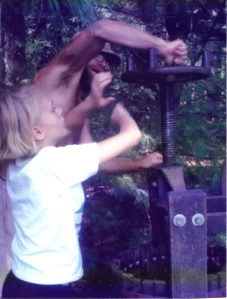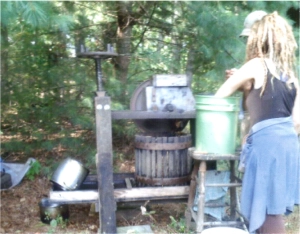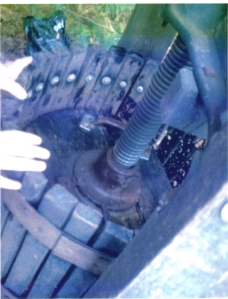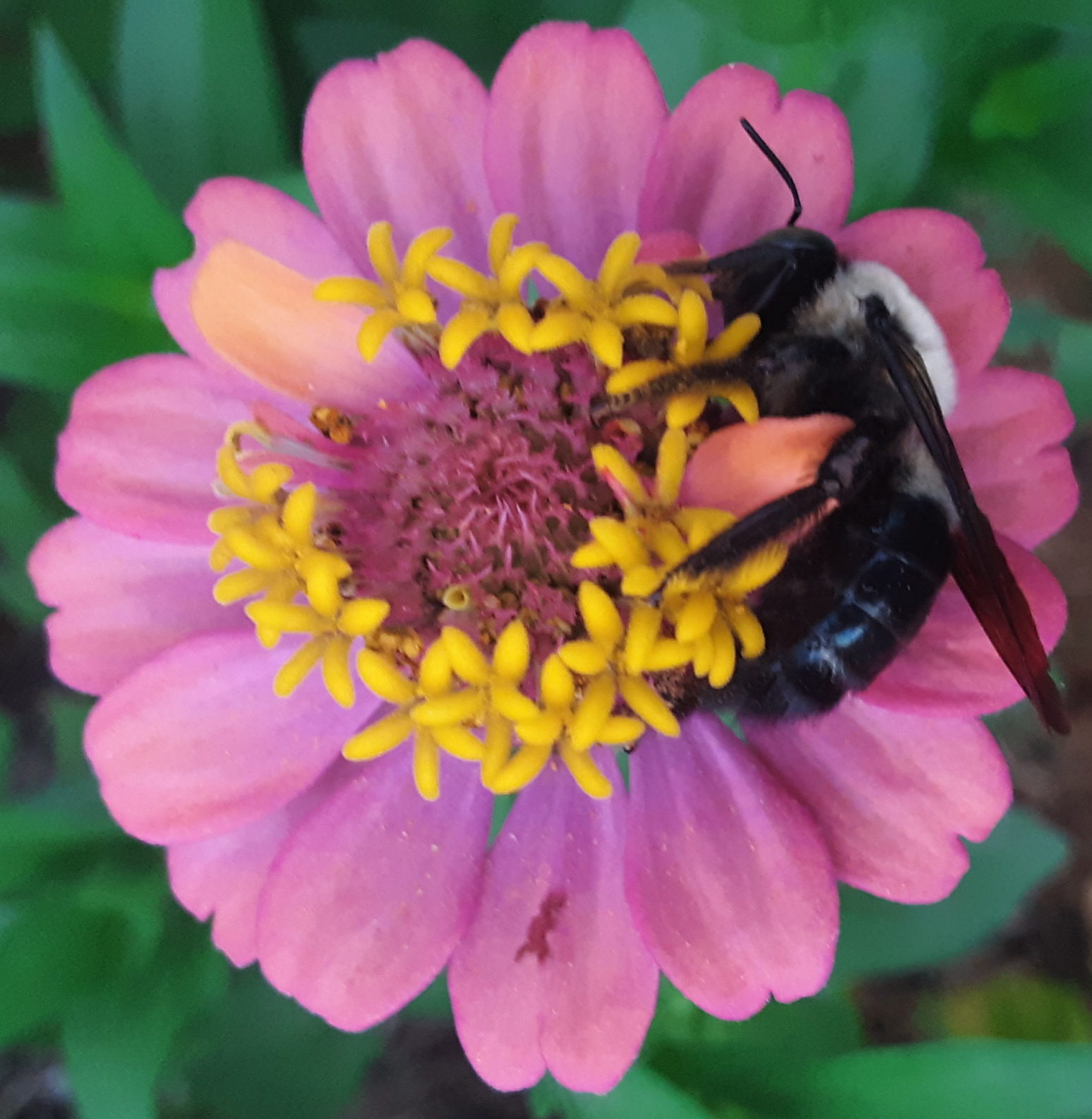
We begin the first pressing of the apples
Over the river and through the woods (and down the road apiece) lies the 150-acre intentional community Springtree. Located on the banks of the meandering and historic Rivanna River, Springtree has been demonstrating so many of the ideals I strive for (and more) for more than thirty years (Now, for more than fifty, Ed.)
I found this out quite by accident when I did a search for permaculture (my passion) in and around Charlottesville and Google turned up the information for a 2-week course to be held there, back in the early 1990s. The course was to be taught by some of the East Coast’s most prominent players in the PC (PC as in ‘permaculture’, not ‘personal computers’) movement, and I wondered: “Did it ever happen?”
I’d certainly not heard of permaculture in my neck of the woods (then rural Virginia Beach) until a couple of years after they’d advertised their workshop espied here in the archives of the digital world. And even when I’d heard the word, it took several insidious repetitions of the word to work its way into my consciousness and become curious of its actual meaning.
In short, I became obsessed with living a more permacultural lifestyle; we left family and friends in familiar territory to move three hours west. The goal was to design a better homestead out of an abandoned barn and fifteen acres, and it would be more comfortable and productive than what we’d had in Creeds (a wetland area in southern Virginia Beach). That was the goal, anyway.
Had we known an integral community had formed and already learned so many things we were attempting, it would have made so much sense to study with them, instead of duplicating some of their efforts, and (I am sure) some of the mistakes they had also made.
Ha! It’s never too late to learn, and thankfully one of the emails on the seven-year-old notice was still good, and I learned that the woman I emailed was none other than the sweet children’s librarian we had seen most Wednesday mornings when we stopped in to get our share of books for the week. She pointed this out in person because I had not linked her name Ruth with her knick name. I knew her by “Toots”; she filled me in on some of the general details that transpired from the course. She also extended a welcome hand for advice and visits.
Unlike some people in the south, Toots really meant that we should visit, genuinely. It took me longer to finally make the five-mile trek to Springtree than it should have, but I finally was able to see the gardens, homes, orchards, and chicken coop of Springtree on a fine spring day. I received a wonderful tour of the place that had nurtured so much love through the years.
On a much larger scale than Horseshoe Hill (it’s a property ten times larger than our place), Springtree reflects the many people who put their time and energy into its vision and its homestead community. It is clear that the people that have continued to live there since the 1970s feel the place is there to share with those who will learn and do likewise. My family has been a grateful beneficiary of this generosity through the past several years, and we’ve gratefully harvested paw paws, persimmon, blackberries, seeds, chestnuts, and apples there. Many fruits have been born of their loving labors.
As former homeschooling parents themselves, Springtree’s remaining four residents have opened their orchards and their cider press on a few occasions, and the taste of that particular cider has spoiled us indefinitely to any other.

Generally, Andy, the agroforester leads us and some boisterous children to the better-producing orchard of the day, and instructs us to avoid poison ivy and sweat bees, while we glean the good apples and relegate the bad ones to the compost pile, so no apple diseases carry over to the following year.
This is not unpleasant work, but it IS work, and I always wonder out loud if my ten apple trees will EVER bear, and when they do, if I’ll be able to induce my children (and others) to help out as avidly as they do in the placid meadows and orchards on this former sheep and dairy farm.
So, we spend a half hour or so, depending upon the “help” the kids offer by picking apples from underneath the trees (and possibly picking some from the trees above) then cart several five-gallon buckets through the gardens over to a nice shady spot in front of the house where thee old cider press lives.
After an initial test, Andy determines we are good to go, throwing in whole apples, imperfections and all. Occasionally a worm sighting prompts me to cut off an end or core a questionable suspect, but for the most part, we delight in tossing them out and watching the apple-rich juice emerge into the wooden bucket below.
The flywheel works and churns and though noisy at times, it is infallible and powers phase one of the cider-making marvelously. After dumping all the apples in and continually emptying the discards into a compost bucket, we dodge the sweat bees and dig in for the most strenuous part of the operation: the pressing.
This is the phase that separates the end product from being called just ‘juice,’ and turns it into a cider. We screw the exceptionally heavy wooden top down as much as possible with our combined efforts as the remaining juice drips down, down. We even use a metal bar to increase our leverage and give additional ‘screw-power,’ for lack of a better term.
Finally, as the last possible drop is extracted, we set up funnels into recycled gallon jugs and former apple juice containers now ready to house a much better product. I feel like the world’s luckiest rustic bartender, taking the bucket to fill up each container, and I try to resist stealing a sip until I am almost done. (In the end, though, it proves impossible to wait).
Once every bit of the delicious cider is poured out, we hose everything off and cart off the discards (peels, seeds, etc.) to the compost. On our short trip home, we may actually guzzle half a gallon of this apple-y deliciousness, but I decide to freeze the other half-gallon so we can enjoy the local bounty long after the last apple in that magical place has fallen.
¡Viva Springtree, muchas gracias para las manzanas deliciosas!

Where the juice gets pressed a second time….and turns to cider.
